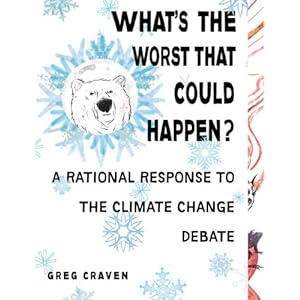
You may have seen Greg Craven's The Most Terrifying Video You'll Ever See. It's been around for a few years and has been viewed millions of times on youtube. In that video he steps through a way for figuring out which risk is greater:
- Failing to act on climate change if the dire predictions turn out to be correct; or;
- Acting on climate change when it isn't needed (because the dire predictions are wrong)
It redirects the question away from (sort of) whether the scientists are right or wrong to a question of how do you appropriately manage risk.
By attending to the feedback on the original video, he reshaped his argument and briefly simplified it in a newer version of the video. That's the video embedded below. He also wrote a book, What's the Worst That Could Happen? that very nicely helps you to evaluate your own and society's risks.
The book steps you through how to answer the fundamental question of the title, for yourself. It pushes the reader to consider (and reconsider) the positions they hold and evaluate the credibility of the authorities they rely on. You are led to develop your own "credibility spectrum" as well as filling in your own chart, akin to the one in the video. Watch the video to see what I mean by the chart.
Throughout the book he pushes the reader to judge for him or herself, to come to his or her own conclusion about whether it makes sense to act as though the scientists are right or that the economic cost of action is too great a risk to bear. While his own position is clear, his approach should be palatable to any reader who wishes to apply logic to the problem.
He notes that he asked many "skeptics" and "warmers" to read drafts of the book and was told by both that he gave too much credit to the other side. That leads him to believe (and I concur) that his presentation is even handed.
I highly recommend the book, though some may find his approach a bit cheesy, in a science teacher sort of way. I admit to being partial to that sort of cheesiness.
I think the approach works for stepping through various risk-laden decisions -- like deciding what to do regarding the Marceullus Shale, for example.
The book steps you through how to answer the fundamental question of the title, for yourself. It pushes the reader to consider (and reconsider) the positions they hold and evaluate the credibility of the authorities they rely on. You are led to develop your own "credibility spectrum" as well as filling in your own chart, akin to the one in the video. Watch the video to see what I mean by the chart.
Throughout the book he pushes the reader to judge for him or herself, to come to his or her own conclusion about whether it makes sense to act as though the scientists are right or that the economic cost of action is too great a risk to bear. While his own position is clear, his approach should be palatable to any reader who wishes to apply logic to the problem.
He notes that he asked many "skeptics" and "warmers" to read drafts of the book and was told by both that he gave too much credit to the other side. That leads him to believe (and I concur) that his presentation is even handed.
I highly recommend the book, though some may find his approach a bit cheesy, in a science teacher sort of way. I admit to being partial to that sort of cheesiness.
I think the approach works for stepping through various risk-laden decisions -- like deciding what to do regarding the Marceullus Shale, for example.

No comments:
Post a Comment